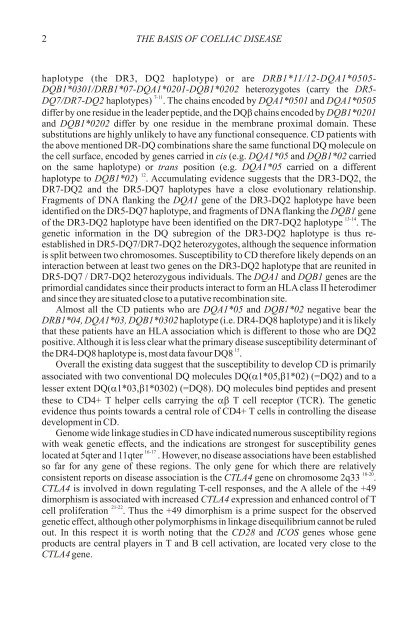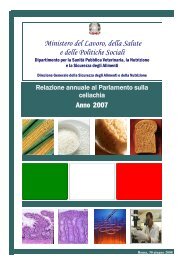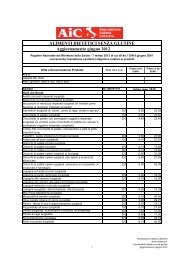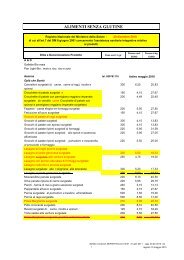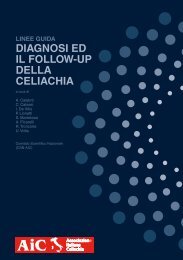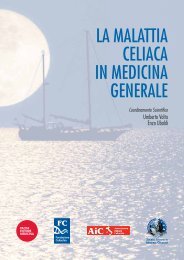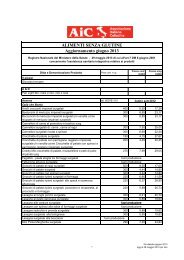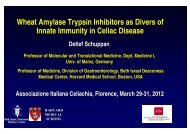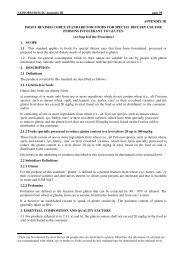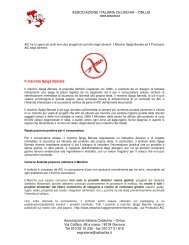primary prevention of coeliac disease - Associazione Italiana ...
primary prevention of coeliac disease - Associazione Italiana ...
primary prevention of coeliac disease - Associazione Italiana ...
You also want an ePaper? Increase the reach of your titles
YUMPU automatically turns print PDFs into web optimized ePapers that Google loves.
2<br />
THE BASIS OF COELIAC DISEASE<br />
haplotype (the DR3, DQ2 haplotype) or are DRB1*11/12-DQA1*0505-<br />
DQB1*0301/DRB1*07-DQA1*0201-DQB1*0202 heterozygotes (carry the DR5-<br />
7-11<br />
DQ7/DR7-DQ2 haplotypes) . The chains encoded by DQA1*0501 and DQA1*0505<br />
differ by one residue in the leader peptide, and the DQbchains encoded by DQB1*0201<br />
and DQB1*0202 differ by one residue in the membrane proximal domain. These<br />
substitutions are highly unlikely to have any functional consequence. CD patients with<br />
the above mentioned DR-DQ combinations share the same functional DQ molecule on<br />
the cell surface, encoded by genes carried in cis (e.g. DQA1*05 and DQB1*02 carried<br />
on the same haplotype) or trans position (e.g. DQA1*05 carried on a different<br />
12<br />
haplotype to DQB1*02) . Accumulating evidence suggests that the DR3-DQ2, the<br />
DR7-DQ2 and the DR5-DQ7 haplotypes have a close evolutionary relationship.<br />
Fragments <strong>of</strong> DNA flanking the DQA1 gene <strong>of</strong> the DR3-DQ2 haplotype have been<br />
identified on the DR5-DQ7 haplotype, and fragments <strong>of</strong> DNA flanking the DQB1 gene<br />
13-14<br />
<strong>of</strong> the DR3-DQ2 haplotype have been identified on the DR7-DQ2 haplotype . The<br />
genetic information in the DQ subregion <strong>of</strong> the DR3-DQ2 haplotype is thus reestablished<br />
in DR5-DQ7/DR7-DQ2 heterozygotes, although the sequence information<br />
is split between two chromosomes. Susceptibility to CD therefore likely depends on an<br />
interaction between at least two genes on the DR3-DQ2 haplotype that are reunited in<br />
DR5-DQ7 / DR7-DQ2 heterozygous individuals. The DQA1 and DQB1 genes are the<br />
primordial candidates since their products interact to form an HLA class II heterodimer<br />
and since they are situated close to a putative recombination site.<br />
Almost all the CD patients who are DQA1*05 and DQB1*02 negative bear the<br />
DRB1*04, DQA1*03, DQB1*0302 haplotype (i.e. DR4-DQ8 haplotype) and it is likely<br />
that these patients have an HLA association which is different to those who are DQ2<br />
positive. Although it is less clear what the <strong>primary</strong> <strong>disease</strong> susceptibility determinant <strong>of</strong><br />
15<br />
the DR4-DQ8 haplotype is, most data favour DQ8 .<br />
Overall the existing data suggest that the susceptibility to develop CD is primarily<br />
associated with two conventional DQ molecules DQ(a1*05,b1*02) (=DQ2) and to a<br />
lesser extent DQ(a1*03,b1*0302) (=DQ8). DQ molecules bind peptides and present<br />
these to CD4+ T helper cells carrying the abT cell receptor (TCR). The genetic<br />
evidence thus points towards a central role <strong>of</strong> CD4+ T cells in controlling the <strong>disease</strong><br />
development in CD.<br />
Genome wide linkage studies in CD have indicated numerous susceptibility regions<br />
with weak genetic effects, and the indications are strongest for susceptibility genes<br />
16-17<br />
located at 5qter and 11qter . However, no <strong>disease</strong> associations have been established<br />
so far for any gene <strong>of</strong> these regions. The only gene for which there are relatively<br />
18-20<br />
consistent reports on <strong>disease</strong> association is the CTLA4 gene on chromosome 2q33 .<br />
CTLA4 is involved in down regulating T-cell responses, and the A allele <strong>of</strong> the +49<br />
dimorphism is associated with increased CTLA4 expression and enhanced control <strong>of</strong> T<br />
21-22<br />
cell proliferation . Thus the +49 dimorphism is a prime suspect for the observed<br />
genetic effect, although other polymorphisms in linkage disequilibrium cannot be ruled<br />
out. In this respect it is worth noting that the CD28 and ICOS genes whose gene<br />
products are central players in T and B cell activation, are located very close to the<br />
CTLA4 gene.


